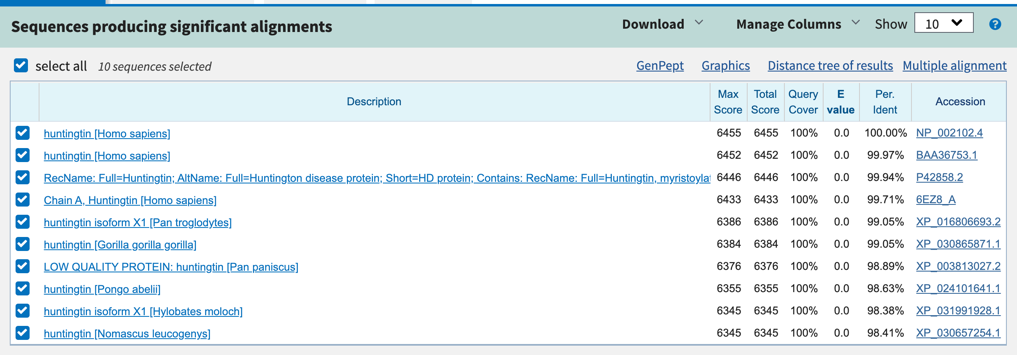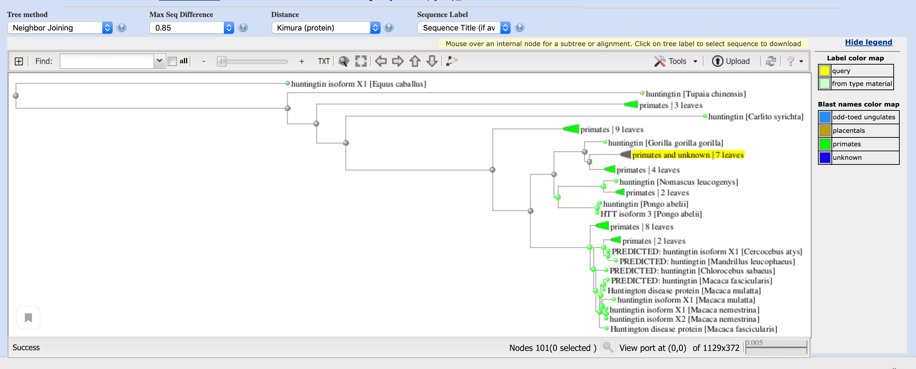Introduction
Huntington’s disease is a hereditary degenerative illness of the human central nervous system, manifested by progressive chorea, neuroleptic extrapyramidal syndromes, and mental disorders. While humankind has known the disease for over 130 years, scientists have come closer to understanding it only with the emergence of the foundations of genetics and molecular biology. The study of Huntington’s chorea has been intensively developed by neuropathologists, psychiatrists, geomorphologists, and geneticists, as evidenced by the extensive scientific literature on the disease. In 1993, the discovery of the gene responsible for Huntington’s disease made it possible to perform almost analytical precision genetic diagnosis for the mutant gene. This research paper aims to discuss the disease from the perspective of the mechanism of origin and development and the observed clinical picture.
Results
OMIM, the medical database that collects information on known diseases with the genetic component and the genes responsible for their development, provides fairly detailed results for describing Huntington’s disease. In particular, information was obtained on the huntingtin protein, whose anomaly leads to chorea (“Disease; HD”, 2020). A biopolymer study using the Protein in the National Center for Biotechnology Information (NCBI) database helped to estimate the protein size of 3144 amino acids (“Huntingtin [Homo sapiens]”, 2020). The structure of the huntingtin protein can be different since the gene polymorphism in the protein contains dissimilar amounts of glutamine residues. The molecular weight of huntingtin depends mainly on the number of glutamine residues, but, on average, it is 348 kDa.
For this study, the Protein section provided information on the coding sequence for huntingtin. This is the HTT gene found in scientific literature and called HD, IT15, and LOMARS (“HTT huntingtin”, 2020). The gene was analyzed using the Gene section of NCBI, which revealed more precise details about the DNA fragment. In particular, HTT is localized on the fourth chromosome of Homo Sapiens at 4p16.3. The tissue-specific analysis of this gene for the biological species Homo Sapiens, shown in Figure 1, illustrates that the expression of the gene is characteristic of all organs and parts of the body. The locus in which the gene is located is significant and has a length of about 180 kilobases and 67 exons (Nance, 2017). Using the GenBank section, it was found that the gene encoding huntingtin has a repetitive CAG trinucleotide sequence (“Homo sapiens chromosome 4”, 2020). The Gene database demonstrated that a mutation in the gene could also lead to Lopes-Maciel-Rodan syndrome. This change represents a single-nucleotide replacement of G by A in position 3,177,388 in the fourth chromosome. OMIM analysis showed that this disorder is characterized by mental regression in infancy, delayed psychomotor activity, and cerebral atrophy.

In this study, the BLAST was also used to find homologs of proteins or nucleic acids for which the primary structure or a fragment of it is known. In particular, a FASTA amino acid sequence was created for the huntingtin protein and loaded into the BLASTp search box. In other words, the homological similarity of proteins to the molecule whose anomaly is responsible for the development of Huntington’s disease was tested. The result shown in Figure 2 highlights the first ten proteins that have different Max Score parameters. The result can be displayed differently with the help of a phylogenetic tree (Fig. 3), which provides information about the evolutionary relationship of the amino acid sequence to typical proteins in other organisms. In particular, Fig. 3 shows that this protein is characteristic for humans but has certain similarities also with monkey biopolymers.


Furthermore, this study proposed a more detailed analysis of the protein structure of huntingtin. For this purpose, Protein Data Bank (PDB), an extensive archive of data on the structures of biological molecules, was used. In this database, a record was found containing information on the mixture of tetrameter and dimer huntingtin obtained using the paramagnetic NMR method (“6N8C”, 2019). Although the protein structure is ambiguous, Figure 4 still shows the presence of a significant number of free N-terminal regions with the potential to enter into complex biochemical relationships. The website confirmed the information that huntingtin mutations characteristic of the HTT gene lead to Huntington’s disease. The critical discovery for this protein is the study of functions shown in Figure 5.


Discussion
Genetic Basis of the Disease
During the growth and development of cells, the most intensive protein biosynthesis occurs to build cellular organoids, and membranes, enzymes, and signal molecules are produced (Hoerter & Ellis, 2019). The basis for building up proteins inside a living organism lies in genetic molecules. The gene is a sequence of nucleotides of DNA ranging in size from several hundred to one million nucleotide pairs. In such a sequence, genetic information about the primary structure of a protein is encoded, which means the number and sequence of specific amino acids. Due to transcription mechanisms, mRNA, which has a relatively smaller size than the original, is formed on the DNA matrix. The beginning of the translation coincides with the stage when mRNA has already left the nuclear structure and muddled to ribosome subunits (Hoerter & Ellis, 2019). In the course of the conveyor reading, mRNA codes are complementarily connected to tRNA anticodons, resulting in the release of amino acid residues. The chemical bonds join the amino acid residues to form a polypeptide, which after a spatial modification becomes a specific protein.
Accordingly, identical processes are the basis for the production of healthy protein, the information about which is stored in the HTT gene. The study by Choudhary et al., (2017) found that the gene of Huntington’s disease, HTT, was localized on the fourth human chromosome at 4p16.3. It is important to note that the gene is expressed in two alternative forms in different cells of embryo and mature organism. The more abundant 13.7 kilobase transcript is mainly expressed in the brain cells of both embryo and adult organisms (Saudou & Humbert, 2016). The smaller transcript of 10.3 kilobases is expressed in a broader range of cells. The genetic defect leading to Huntington’s disease is due to the expansion of an unstable CAG trinucleotide repetition into a gene that is translated into the protein as a polyglutamine recurrence. Normal alleles contain between 9 and 35 CAG repeats, while the higher content is associated with disease progression (“Huntington disease”, 2020). In terms of the pathological effect of the protein structure, neural cell death is caused by the process of N-terminal cell fragments invasion.
In Huntington’s disease, the mutation affects the body in two ways: the loss of normal protein functions and the acquisition of new pathological functions. The increasing number of CAG repeats leads to the formation of unstable conformation and accumulation of protein conglomerates in the cytoplasm and the cell nucleus. Mutant protein forms aggregate with other proteins, involving other cellular systems in the pathological process, and formed intracellular deposits are toxic to the cell itself.
It is worth noting that the natural function of a protein encoded with HTT is still unknown to medical science. Its highest concentration is in the brain, skin and testicular cells, and lymph nodes (Figure 2). The synthesized protein huntingtin is located in the cytoplasm, takes part in signal transmission in the cell, and prevents its programmed death (Saudou & Humbert, 2016). It was found that huntingtin can directly interact with many other proteins (Figure 5). Huntingtin is associated with microtubes, vesicular membranes, and neuronal synaptosomes, which allows making judgments about its participation in endocytosis and cytoplasmic transport. Huntingtin can participate in transporting vesicles and maintaining the cytoskeleton.
Clinical Picture
The clinical picture of Huntington’s Disease refers to hereditary diseases with a dominant type of inheritance and with the almost complete penetration of a mutant gene. The most typical manifestations are choreic hyperkinesis and progressive dementia. The classic hyperkinetic form in most patients makes its debut at the age of 30 years and older (“Huntington disease”, 2020). Long before a detailed clinical picture emerges, anxiety gradually develops, increased patient activity, movements become widespread, often uncoordinated, and gesticulation becomes excessively lively. As the disease progresses, more muscle groups become involved in the pathological movements. As a result of the involvement of muscles in the torso, gait is severely impaired and unstable walking and resting. The contractile muscles in the digestive system are also affected, resulting in impaired food absorption functions.
The disease is characterized by the development of mental disorders. The initial stages are dominated by depressive and anxious disorders. Lassitude, attention deficits, memory loss, and reduced ability to learn new material, as well as increased excitability, are typical of the disease. Individual patients may experience more complex behavioral disorders in the form of a tendency to be alone, delusional interpretations of reality, and hallucinations. Cognitive dysfunction is described by relatively slow progression hence that patients may remain functional for a certain period within their normal activities (Zielonka, 2018). If the disease progresses, cognitive impairment may reach a degree of severe dementia: complications of the disease develop 15-20 years after onset (Saudou & Humbert, 2016). Genetic mutation leading to neurodegenerative disease is not common: the U.S. National Library of Medicine estimates that Huntington’s disease affects between 3 and 7 people per 100,000 units of the European population (“Huntington disease”, 2020). At the same time, the authors especially emphasize that representatives of the Asian and African genetic families are less susceptible to mutations.
Conclusion
The genetic and protein component of Huntington’s neurodegenerative disease was analyzed in this research work. Using the Protein, Gene, and BLAST on NCBI, a thorough study was carried out and the expected facts were identified. In particular, it was shown that disease is caused by a mutation in the HTT gene that brings about the number of nucleotide repetitions of CAG to exceed the limit. This causes anomalies in the synthesis of the huntingtin protein, increasing the toxic properties of the molecule. It has been shown that an alternative mutation in the HTT gene leads to a neurodegenerative disease known as Lopes-Maciel-Rodan syndrome. This study demonstrated the foundation of the problem but did not focus on the diagnosis and treatment of the disease. Already today, doctors around the world are successfully applying PCR tests to detect the disease and take preventive measures. Further search can be aimed at a detailed discussion of testing mechanisms and modern methods of treatment of patients.
References
- 6N8C. (2019). PDB.
- Basic local alignment search tool. (n.d.) NCBI. Web.
- Choudhary, A., Minocha, P., & Sitaraman, S. (2017). A case report of juvenile Huntington disease. Journal of Pediatric and Neonatal Individualized Medicine, 6(2), 1-4. Web.
- Disease; HD. (2020). OMIM. Web.
- Hoerter, J. E., & Ellis, S. R. (2019). Biochemistry, protein synthesis. StatPearls Publishing.
- Homo sapiens chromosome 4, GRCh38.p13 Primary Assembly. (2020). NCBI.
- HTT huntingtin [ Homo sapiens (human)]. (2020). NCBI. Web.
- Huntington disease. (2020) U.S. National Library of Medicine.
- Huntingtin [Homo sapiens]. (2020). NCBI. Web.
- Nance, M. A. (2017). Genetics of Huntington’s disease. In A. S. Feigin & K. E. Anderson (Eds.), Handbook of clinical neurology (pp. 3–14). Elsevier.
- Saudou, F., & Humbert, S. (2016). The biology of huntingtin. Neuron, 89(5), 910-926. Web.
- Zielonka, D. (2018). Factors contributing to clinical picture and progression of Huntington’s disease. Neural Regeneration Research, 13(8), 1364-1365.